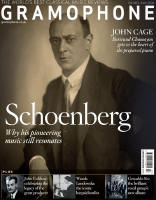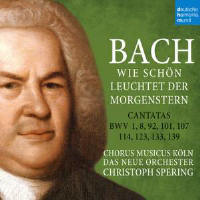Texte paru dans: / Appeared in:
|
|
|
|
|
|
Post-war recordings of Bach cantatas from Germany are a richer repository than is generally known, outside those on the major labels from the likes of Richter and Rilling. Largely forgotten from the vinyl era are a tranche of cantata performances from regional mixed choirs and chamber orchestras under Kappelmeisters Grischkat, Goettsche, Werner, Heintze, Ehmann, Doorman, Gönnenwein and several others. It was their quiet advocacy that gave us musical direction akin to the patience of a harbour-master riding with the tides.
Christoph Spering’s celebration of the tercentenary of Bach’s second cycle of cantatas in Leipzig (the so-called ‘Chorale Cantatas’ from 1724-25) has an affinity with this style of performance, which takes each work on its own terms, without the razzle and dazzle of many modern groups. A chamber choir, updated with today’s lingua franca of period instruments, removes it in several respects from the above-named 1950s and ’60s readings on labels such as Carus or Cantate. Yet the simplicity of utterance in the genial discipleship of tenor Daniel Johannsen’s aria ‘Unser Mund’ from Cantata No 1 has Helmut Krebs ringing in our ears from that affecting 1952 recording with Fritz Lehmann (DG). Likewise, Marie Seidler’s assured presence in the fine alto aria of No 114 effects a similarly reassuring lineage. What is perhaps the most attractive feature of Chorus Musicus Köln and Das Neue Orchester’s carefully selected works from Bach’s most unified cycle of cantatas is – despite the aforementioned cultural resonances – how strongly and freshly differentiated they feel. No 107, a treasure trove of succinct arias (unusually without preceding recitatives and da capos), simply irradiates after its gloriously mollifying opening chorus. Then we have the restless exhortations of No 92 and, through the everthoughtful avenues of Bach’s (and Spering’s) treatment of the pervading chorale material, that intolerable burden of sin portrayed in No 101. Spering finds rare pathos within the dissonance and skewered lines of this remarkable quasi-late-Brahms canvas, as he does a glowing tenderness in the opening chorus of No 139.
These are not performances where redhot ensemble, exquisitely luminous textures and purring soloists become the watchwords, in the Gardiner, Herreweghe and Suzuki moulds. Instead, we have an even and highly responsive roster of solo singers, sans ego, a well-blended if not super-focused choral presence and an unerringly gracious rapport between instrumentalists and singers. These qualities are attended by steady tempos and sturdy bass lines, which contribute to the impressive unfolding narratives of some of Bach’s greatest choruses – Nos 92, 101, 123 and 133 as fine examples.
Spering’s unaffected way with Bach’s individual works continues to remind us that sharp-edged grip, incessant energy and digital exactitude are not always sufficient answers in Bach. These are sincere, rooted, unrushed and discriminating interpretations of nine great cantatas. Unlike the relatively uninhibited performances in a recent set of first-cycle cantatas from Gaechinger Cantorey and Hans-Christoph Rademann, these Cologne musicians open new worlds. The emotional landscape of the heartlands of German Bach performance are in safe hands here. |
|




